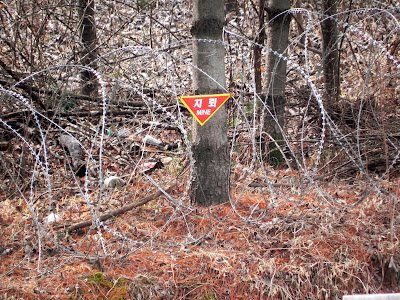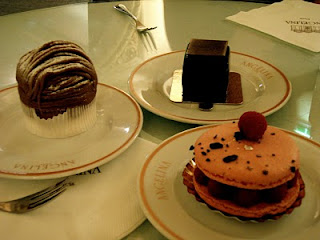The DMZ

However, the Republic of Korea (ROK) is using the DMZ to its economic advantage, allowing visitors to tour the DMZ and learn about some of the history of the Korean peninsula. My friends and I took a half-day tour of the DMZ to the observation deck, the last train station, and the third tunnel.

Standing on deck of the observation tower just outside the DMZ on the South Korean side you can see that the two kilometers of South Korean land is dense forest while the North Korean side is almost devoid of trees, thanks to resource grabbing by the various Kim regimes. Though it was not a clear day, we were able to look through the scenic viewers to see the 160 meter North Korean flag waving on the other side of the DMZ. The 100 meter South Korean flag sits lower than its North Korean counterpart after the Southern government decided to desist in an illogical "flag-war" in which the Southern and Northern governments built increasingly higher flagpoles to "out-do" the other.

Photo of me taken at the observation deck by Chiara Amodeo
We also learned that the only populated village in the DMZ is the prosperous and tightly controlled Freedom Village. While every other South Korean is required to serve in the military, residents of Freedom Village are exempt from duty. Additionally, the residents of Freedom Village can make a good living (around 100,000 USD annually) growing ginseng. The medicinal root takes six years to mature, though it can be harvested early for other purposes or a less potent and less expensive product, and is regulated by the government, which has the exclusive right to distribute and sell six-year ginseng. The people in Freedom village live free of taxes, thereby increasing the economic benefit of living in the village. However, due to tight regulation and control, residents are closely monitored. Any male villager who marries a woman from outside the village may live with her in Freedom Village. However, any female who marries a man from outside the village must leave the village with her husband.
The third tunnel is a small, dark underground tunnel dug by the North Korean side and discovered by the South Koreans back in the 1970s. The North, which had already dug two other tunnels at this point, dug all the way passed the DMZ and into South Korean territory, hoping to launch a surprise attack on the South. At first the North denied having dug the tunnel, but overwhelming evidence presented by the South, such as the dynamite holes all facing southward, pressured the Northern government to concede.
At school we had just started discussing the Six Party Talks, and I was in the middle of researching a paper on North Korean negotiation, so this trip to the DMZ could not have been better timed. Upon my return to school, we all followed the North Korean missile announcement closely, discussing its relation to the Six Party Talks and overall international security. Having seen the DMZ--even just a small, highly-touristic piece of it--gave me a better picture of North-South relations and current security issues. It's definitely worth a trip.


Comments
Post a Comment